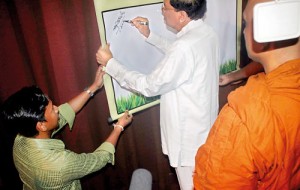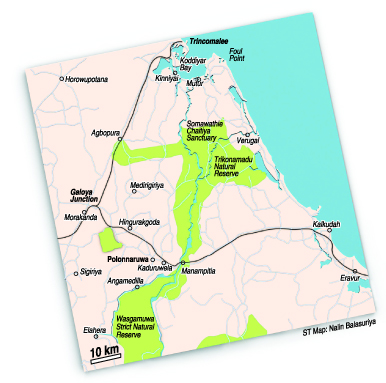News
Sand mining mafia’s days numbered
President Maithripala Sirisena, who himself took on the Environment portfolio, will halt sand mining in Polonnaruwa from today (February 1).

President Sirisena who holds the environment portfolio gets tough on sand mining
He has also ordered his officials to evaluate sustainable river-sand mining and look into alternatives.
There has long been small-scale sand mining in the flood plains around Manampitiya Bridge in Polonnaruwa but operations rose sharply some years ago as demand for river sand increased and organised goons entered the market.
Sand from the banks of the Mahaweli River also began to be removed illegally on a large scale.
The flow of the Mahaweli causes sand to accumulate around Manampitiya Bridge in Polonnaruwa, creating a flood plain around it. These special features have created several villus, creating a flood plain harbouring wildlife.
Given its high biodiversity and strategic importance the area has been declared one of the four national parks set up under the Mahaweli Scheme.
The removal of sand, however, poses a huge threat to the national park.
 The flood plain is a rich feeding ground for elephants and important as a grazing ground in the dry season. It serves as an elephant corridor for jumbos moving between Wasgamuwa and Somawathiya national parks.
The flood plain is a rich feeding ground for elephants and important as a grazing ground in the dry season. It serves as an elephant corridor for jumbos moving between Wasgamuwa and Somawathiya national parks.
If the villus go dry, the elephants that feed on the nutrient-rich grass could start raiding the nearby villages, increasing human-elephant conflict, say wildlife officers, urging an end to sand mining in the flood plains.
River-sand mining has been regulated by the Mines and Minerals Act since 1992 but illegally mined sand continues to come onto the market.
With the intention of providing a monitoring mechanism on sand transportation the law was amended in 2004, making it mandatory to obtain a permit to transport sand but it is alleged there are many loopholes in the law that allow gangs to continue their rackets, bribing law enforcement officers in the process. During the previous regime there was an attempt to abolish the existing rules.
Sand mining in Polonnaruwa is being carried out by a well-controlled mafia and no unknown intruder was even allowed to visit the area by the thugs who operate the racket.
Given these factors, environmentalists welcome the new Environment Minister as it would be easier to implement conservation decisions as the Minister is also the head of the country. Mr. Sirisena held the portfolio from 2005 to 2007 under the previous regime.
Wildlife money makers only?
Environmental groups – reported in this paper last week as urging that the Department of Wildlife Conservation (DWC) should be placed within the Ministry of Environment – are frustrated that it has instead been assigned to the Ministry of Tourism.
“The main function of the Wildlife Department is to conserve Sri Lanka’s biodiversity. But assigning the DWC to the tourism portfolio suggests that wildlife are considered only as money-makers,” one concerned environmentalist said.

